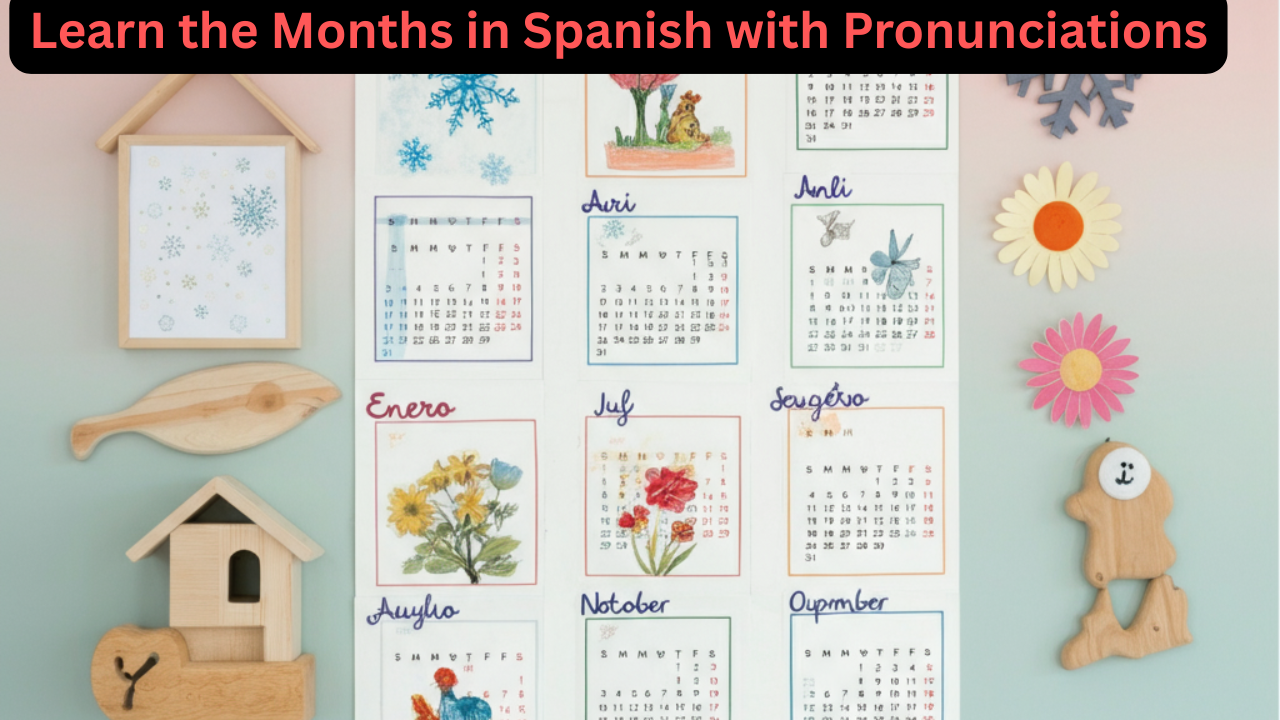Learning the months in Spanish is an essential step for anyone starting their Spanish language journey. Whether you’re planning to travel, taking Spanish classes, or simply looking to expand your linguistic abilities, knowing how to say and use the months can make all the difference in communication.
By the end of this guide, you’ll not only know all 12 months in Spanish but also their pronunciations, grammar rules, and practical usage in sentences.
Dive in and make mastering the months in Spanish your next linguistic milestone!
Why Learn the Months in Spanish?
The months in Spanish are incredibly useful in daily conversations. They’re frequently used in dates, schedules, and celebrations. Whether you’re setting up a meeting or talking about your birthday, knowing the months can significantly boost your ability to communicate better in Spanish.
For example:
- Booking a trip? You’ll need to know “junio” (June) or “diciembre” (December).
- Planning to meet someone? The phrases “en marzo” (in March) or “en octubre” (in October) will come in handy!
Learning this small yet crucial
List of Months in Spanish (with English Translation)
Here’s a clear table listing all 12 months in English, their Spanish equivalents, and their pronunciations to help you master them easily.
| English | Spanish | Pronunciation |
|---|---|---|
| January | Enero | eh-NEH-roh |
| February | Febrero | feh-BREH-roh |
| March | Marzo | MAHR-soh |
| April | Abril | ah-BREEL |
| May | Mayo | MAH-yoh |
| June | Junio | HOO-nee-oh |
| July | Julio | HOO-lee-oh |
| August | Agosto | ah-GOHS-toh |
| September | Septiembre | sep-tee-EHM-breh |
| October | Octubre | ohk-TOO-breh |
| November | Noviembre | noh-vee-EHM-breh |
| December | Diciembre | dee-zee-EHM-breh |
✅ Tip: Notice that all Spanish months are written in lowercase, unlike in English!
Spanish Grammar Note: Capitalization Rules
One of the most noticeable differences when learning Spanish is that months are never capitalized unless they appear at the beginning of a sentence.
- Correct: Mi cumpleaños es en marzo.
- Incorrect: Mi cumpleaños es en Marzo.
Make a mental note of this rule to avoid common mistakes!
Pronunciation Guide (Phonetic Support)
Each month in Spanish has a distinct pronunciation. Here are a few additional tips for speaking them confidently:
- Stress the correct syllable: For instance, “febrero” stresses the second syllable (feh-BREH-roh).
- Practice rolling your “r” sounds in words like marzo or febrero.
Listening to native speakers can also help fine-tune your pronunciation. If you’re unsure, apps like Forvo or YouTube videos on Spanish months are great for practicing pronunciation.
How to Use Months in Spanish Sentences
Now that you know the months and how to pronounce them, let’s see them in action with everyday sentences.
- Expressing a birthday:
“Mi cumpleaños es en marzo.”
(My birthday is in March.)
- Referring to a specific month:
“El año escolar empieza en septiembre.”
(The school year starts in September.)
- Talking about plans:
“Nos vamos de vacaciones en julio.”
(We’re going on vacation in July.)
Practice Exercises
Looking to reinforce what you’ve learned? Here are a few interactive exercises to test your knowledge.
Fill in the Blanks:
- Enero, febrero, ____, abril.
- Mi hermana nació en ____ (September).
- La Navidad es en ____.
Match the English month to the correct Spanish month:
- May –
- October –
- December –
Challenge yourself and see how quickly you can complete these!
External Source
For additional information on learning Spanish vocabulary, visit StudySpanish.com, a trusted resource for grammar explanations, vocabulary lists, and pronunciation guides to help you enhance your language skills.
Downloadable Flashcards
Want to make learning fun and visual? Download our free printable flashcards featuring all 12 months in Spanish, along with their English translations and phonetic pronunciations. It’s perfect for quick study breaks or even teaching kids.
[Download Flashcards]
Frequently Asked Questions
How do you say all 12 months in Spanish?
All 12 months are:
enero, febrero, marzo, abril, mayo, junio, julio, agosto, septiembre, octubre, noviembre, and diciembre.
Are months capitalized in Spanish?
No. Unlike in English, months in Spanish are written in lowercase.
How do you remember the months in Spanish?
Use mnemonic devices or practice paired with visual aids like flashcards. Listening to Spanish audio resources or songs can also reinforce your learning.
Make Spanish Months Part of Your Life
Learning the months in Spanish is more than just memorization; it’s about connecting with the language and culture. Use them in your everyday life by incorporating Spanish into your schedule, whether it’s planning your week or jotting down events in your calendar in Spanish.
Start practicing today with a friend, or bookmark this guide for quick reference. And if you’re eager to continue learning, don’t miss our next blog post on Days of the Week in Spanish.
¡Buena suerte! (Good luck!)
Read Also: How to Say Happy Birthday in Spanish
Read Also: Vegetables in Spanish‑A Complete Guide







